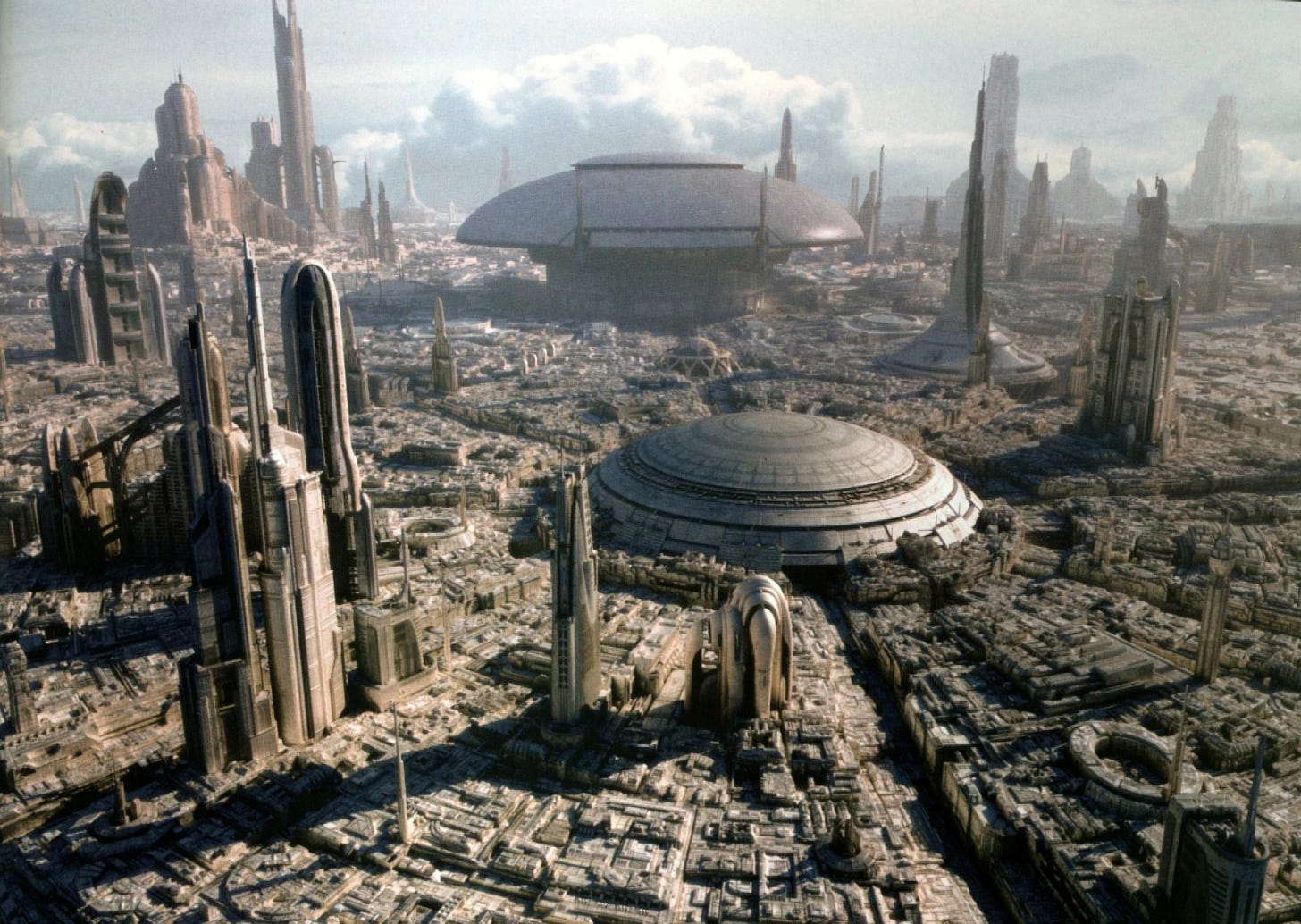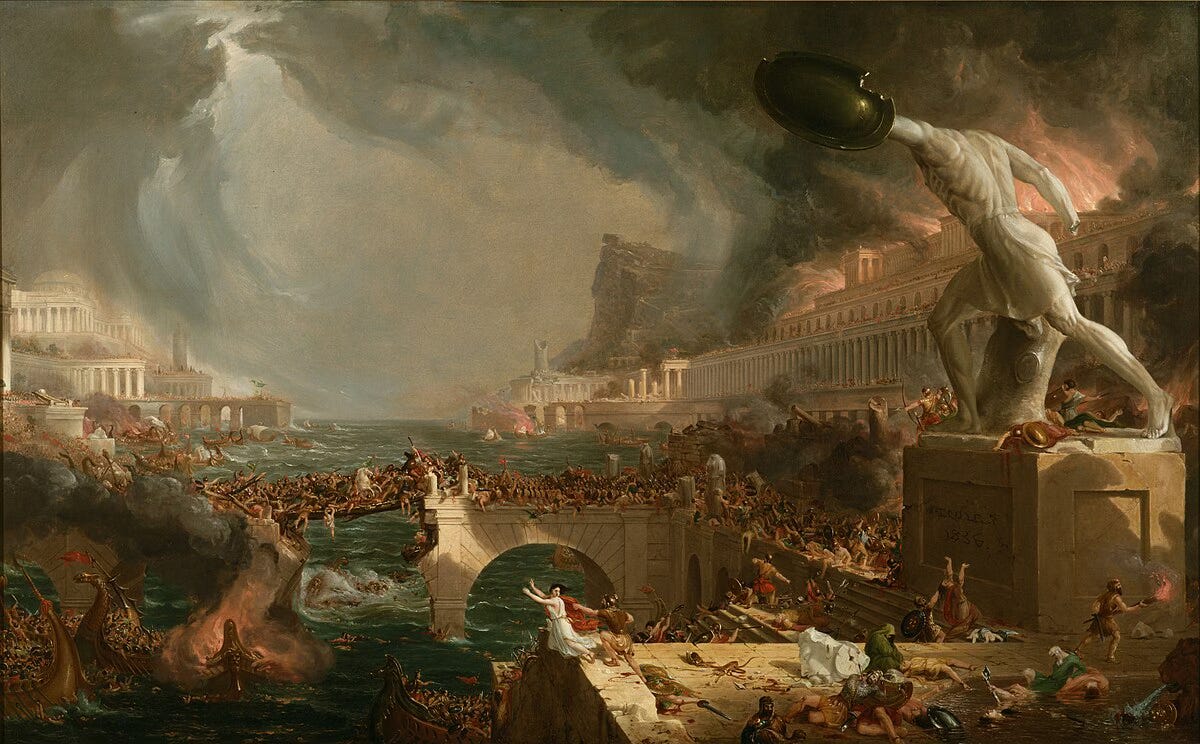Towards The Third Timeline
A Human-Friendly Future Beyond Collapse and Grey Aliens
The Third Timeline, as per Anjan Katta and Peter Limberg1, is the timeline of techno-realism, of Solarpunk and evolutionary harmony, of human and biological flourishing.
It is, I believe, the most memetically fit frame to orient cultural evolution towards wisdom. As such, if my premises are true, the Third Timeline is one of the most important – and underdeveloped – philosophical concepts of our time. In some sense, it’s what Alignment at Large is ultimately about.
A brief personal note
I returned from Mexico to Germany three days ago, after two months that turned out to be much less productive than I anticipated. It wasn’t quite the right space for creative output. I need my desk, silence, everyday things on autopilot. The cold air helps, too.
The creative process isn’t linear. It’s almost shamanic at times, erratic bursts of clarity and creativity. A lot of what I attempted to do while in Mexico, was a more rigid approach to intellectual production, putting building blocks together, trying to write definitive stuff.
Impossible, for me, right now, in this inquiry.
This thing lives, and breathes, and wants to be related to, in all its complexity. Writing essays infused with personal anecdotes might not be the way to build intellectual legitimacy...2
But not publishing for two months, as the result of a more rigid approach, doesn’t quite serve the work either. Alas, with this little prelude, here’s an introduction to my upcoming series Towards The Third Timeline.
It’ll be unorthodox, raw, eccentric. Unpolished at times. Apparently it cannot be otherwise for now. So gracias, for indulging me. May it make sense.
Third Timeline, huh? What are the other options?
Timelines 1 and 2 are about Techno-Optimism and Techno-Pessimism. Their manifestos are Marc Andreessen’s Techno-Optimist Manifesto3, and Ted Kaczynsky’s Industrial Society and Its Future, also known as the Unabomber Manifesto4.
Blind belief in exponential technological progress on one side, rage at the techno-capitalist machine and the call to action to make it all collapse on the other.
Katta and Limberg, in the manifesto, call them the “Collapse” (1) and “Grey Alien” (2) timeline respectively.
I have some disagreements, which we’ll get into in more depth throughout the series, but the gist is this:
Techno-Optimism should be Timeline 1, as it’s the default direction that the world is moving in.5
“Grey Alien” — a hint at the increasingly immersive and subsuming nature of technology in relationship to the human body, leading to a more and more “dissociative, disembodied, dehumanizing” experience of the world that ultimately evolves humans towards bigger heads and smaller bodies — is succinct, but I believe incomplete.
Generally, it seems worthwhile to spell out all the different sub-timelines. There are many failure modes to blind Techno-Optimism: planetary scale GPU clusters, ecumenopolis (a city spanning the entire surface of the planet), many flavors of authoritarianism (1984, CCP, WEF, …), etc.
There are also of course all the utopias and “glorious future”6 vibes that techno-optimists point to, like what we might call “New American Dynamism”7, Machines of Loving Grace8, etc, which at least promise some hope. It’s worth steel-manning them, even if it’s just to find that they’re indeterminately optimistic and epistemically challenged.
While my intuition says that no good future can come from an optimism that didn’t have the courage and intellectual honesty to look at itself in the mirror, to have its existential crisis, and to emerge with more self-awareness, respect, “green” (we’ll get to that), and overall maturity — it’s worth getting really precise about what delineates those futures.
Similarly, “all roads lead to Rome”, which is to say there has never been an immortal civilization, there are many paths to collapse and chaos. It doesn’t have to be done by an unemployed math professor and eco-terrorism, it can happen through institutional decay, overregulation, degrowth, population collapse, etc. Here, too, it’s worth mapping the available futures and identifying what exactly is the threat.
More generally, this second timeline has vibes of “not winning”; if you over-regulate, retreat into the woods, or otherwise bomb your means of production and the fitness of your country in the global marketplace of products and ideas — you might just get outcompeted by the disembodied, Adderall-fueled startup bros you were trying to steal the future from, who end up enjoying the influence and resources that moloch and the machine gods offer them.
All this is commentary, the overall framework of three timelines is brilliant. Which leads us to …
Solarpunk Timeline

“Choosing a future that avoids both the Collapse and the Grey Alien timelines is possible.
There is an alternative timeline we can choose to manifest. The future we are choosing can be termed the “Solarpunk Timeline.” This designation is not necessarily an endorsement of Solarpunk philosophies or politics but rather an appreciation for the aesthetic imaginaries they envision.
In the Solarpunk Timeline, screens exist outside our bodies, encouraging us to be fully present within our bodies, connected with nature, and engaged in harmonious creation with the whole. Instead of being immersed in our screens and increasingly digitizing our lives, we will be exposed to reality, returning to more analog ways of being.”
On the level of personal lifestyle, vibes, and health, the moral superiority of this direction should be immediately clear to anyone with a body.
Evolutionary mismatch as produced by Limbic Capitalism — reverse-engineering human vulnerabilities emerging from evolved biological mechanisms to ruthlessly optimize for the extraction of attention, market dominance, control, predictability, etc — is not something mature humans wish for people they love.9
The pursuit of healthier, more human-friendly technology is the natural conclusion, in search of increasing levels of evolutionary harmony.
Instead of just technology or just nature the core value here is about wholeness. About synergistic design. About Ergonomics and aliveness. About respecting the wisdom of nature, and stewarding our god-like technological powers with care. About appropriate epistemic humility. About seeing reality more clearly. About existential maturity.
Yes, there are many more questions: What makes technology human-friendly? How do we scale that to the level of global capitalism? What about the great fact, numbers going up, “progress” being in service of humanity? How do you actually direct civilization in that direction? What is Solarpunk in practice?
Speaking of Solarpunk, it’s a beautiful vibe, but seems to be not much more than that. Crucially, something I’ll want to look at in this series is how Solarpunk lacks a certain realpolitik vibe; how it takes for granted the stable, peaceful, civilized features of Western democracies; how those in term are enabled not least by wealth and might, guns and oil.
I’ll resist the temptation of outlining the parts of this series. I have hunches, intuitions, drafts; many of them I touched on above or in previous piece. But I'm most curious to simply pull on the thread and see what happens.
From “green-according-to-blue” and techno-humanism, to why buying yoghurt is key to a Solarpunk future — this series promises to be interesting.
☀︎ Written at night on a Daylight Computer — a healthier, more human-friendly approach to computing. Featuring amber backlight and the world’s first paper-like display that’s super-fast and blue-light-free. It’s like a Kindle, made for focused knowledge work. ☀︎
Anjan Katta was the source* of these concepts, Peter Limberg acted as the scribe in writing the manifesto, which hasn’t yet been published.
Anjan is the founder and CEO of Daylight. I worked with him and the Daylight team on and off over the past 2.5 years.
Peter is the steward of The Stoa, writes Less Foolish, and was Philosopher-in-Residence at Daylight last spring, when that manifesto first got drafted. He also wrote about it here.
* in the Peter König sense
I’ve been inspired by Samo Burja’s series on Intellectual Legitimacy, highly recommend reading if you’re trying to change society with ideas
The Techno-Optimist Manifesto — Marc Andreesen, October 2023
Industrial Society and Its Future — Ted Kaczynski, 1995. Full length version here.
Anjan pointed out to me that he named Unabomber/collapse timeline 1 because it’s going back in time. I can see how that makes sense, it references the “original” state of nature we’ve departed from. But from where we are today, looking to the future, I do feel techno-optimism is the default.
“We are beginning to turn our aim beyond that, to superintelligence in the true sense of the word. We love our current products, but we are here for the glorious future.”
— Sam Altman, January 06th 2025
Building American Dynamism — Katherine Boyle, A16Z
Machines of Loving Grace, October 2024 — Dario Amodei, CEO of Anthropic
Countless examples of tech executives not letting their kids use smartphones and social media: Steve Jobs, Bill Gates, Chamath Palihipitiya: “I can control my decision, which is that I don’t use that shit. I can control my kids’ decisions, which is that they’re not allowed to use that shit.”




You may also like Second Renaissance visioning https://secondrenaissance.net/ ...
As the saying goes, life is what happens while we are making plans. Similarly, one good outcome of all the manifests is that they outline what will not happen.
There are many reasons why it is so. The general idea is that people underestimate not just the complexity of the world, but underestimate how much they underestimate. The closer one gets to approximating these estimations the less one engages in making manifests like these.
In the literal sense the 20th century was the darkest of the Dark Ages humanity has faced, and will face. Technologies like mass media, TV, and then the Internet and the social networks on one side, and reductionist world view inspired by science on the other side, led humans into forgetting who they are, and instead believing they are mechanistic automatons driven by the biological drivers, monkey OS basically.
Never before were there technologies to make this happen. Also, this approach does not scale indeed, so this mess can’t continue for long. A new version of human software needs to emerge, and is emerging very actively, if you know where to look for it.
That’s what Nietzsche was trying to say, but even he did not understand the meaning of it fully. He thought there will be Übermenschen with all the new software, but they will be continuing playing monkey games. No, new software plays new games.
The problem with all these manifests is that they are also playing these old monkey games, and induct off them, leading to all kinds of strange constructs.
The nature of reality is much much more deep and advanced than the current scientific view. The nature of forces driving it are much much more deep and advanced, and their nature is unexpected to the greatest possible extent. Without understanding those factors all the projections are meaningless, that is, missing any meaning.
What does have meaning is humans uninstalling the old monkey software. This is the way, the truth and the foundation for the life as it will be. Everyone needs to fix themselves. Everything else follows from this.
So the actual question is how does one do this fixing, not how to fix “the world” without fixing what activity needs fixing.